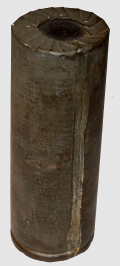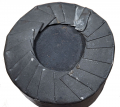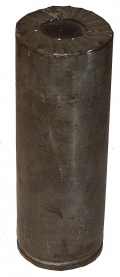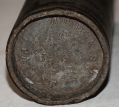site search
online catalog
ORIGINAL CIVIL WAR NON-EXCAVATED 3-INCH HOTCHKISS CANISTER ROUND
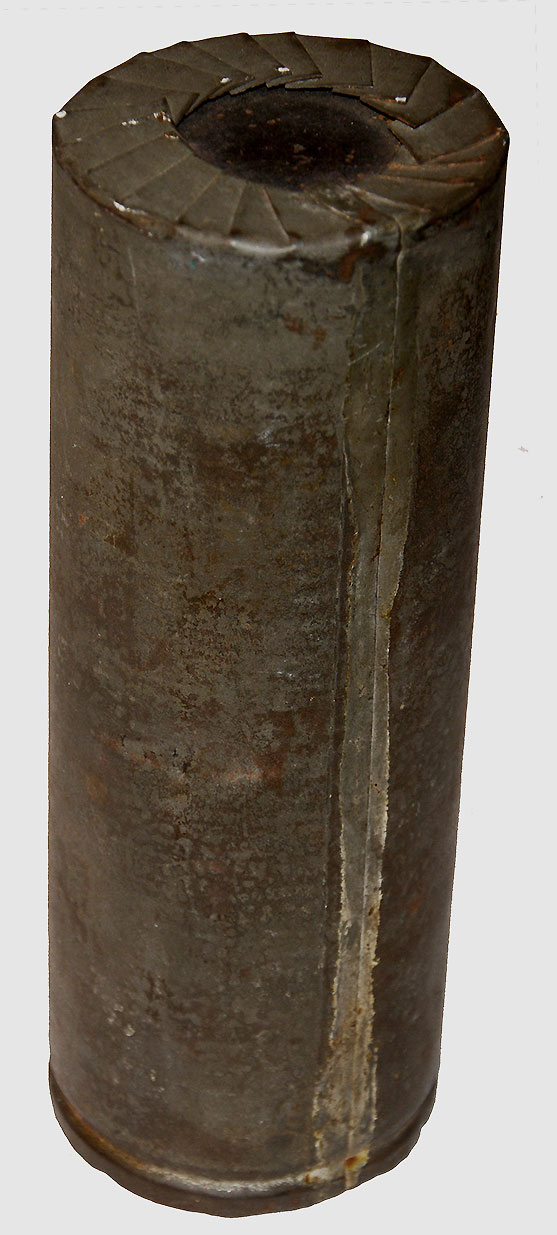
$3,795.00
Quantity Available: 1
Item Code: 2025-37
Shipping: Determined by Method & Location of buyer
To Order:
Call 717-334-0347,
Fax 717-334-5016, or E-mail
Measuring 2.9” in diameter and 8” tall, and weighing 6 pounds 15 ounces, this is an original, non-excavated, complete, intact and nicely marked Civil War canister round for the 3-Inch Ordnance Rifle. This is an original, surplus Civil War round, not assembled from excavated parts. The condition is excellent. The tinned iron case shows as a uniform gray with no exposed iron and the soldered vertical seam is a lighter silver gray color. The iron plate in place in the top, held under the folded flanges of the side showing black with a slight bluish tint and no rust. The body has a slight dent on one side near the top and another elsewhere about halfway down. The lead base is in place, secure, fully intact, and clearly marked in raised letters on the underside of the cupped bottom: “HOTCHKISS / 3 IN. / JAN’Y 7. / 1862 / PATENT.” According to Dickey and George, the U.S. government purchased 100,372 of these rounds, making them a widely used, close-range, anti-personnel round.
Benjamin Berkeley Hotchkiss (1826-1885) was an American ordnance engineer and inventor (later setting up for business in France as well.) In this case his patent (#34058, not “#34085,” a misprint in Dickey and George followed by other authors) was for the use of an interior case that had longitudinal divisions cut at an angle so at to resist outside pressure, but yield to internal pressure, hindering the case from being damaged and deformed in transportation or in moving across the grooves of the rifling, thereby preventing a ball being wedged in the rifling in Hotchkiss’s view, but permitting the case to separate easily enough on exiting the muzzle. He also used a cupped lead bottom (poured into the case in the manufacturing process) into which the powder bag might be folded during transportation until extended and filled to make it a fixed round for use in the field. Hotchkiss initially envisioned using a plate within the bag to hold it within the cup by a screw and tying closed the open lower end when closed. At some point before production, this was apparently dropped and the base was given a simple groove, enabling a powder bag to be tied on in a more conventional way, but still keeping with his idea of obviating the need for a sabot. Ironically, he made specific mention of the cupped base’s ability to “expand and fill the bore, like a Minie ball.” In the view of most modern authors, this was a defect in the design, causing it to take the rifling when fired, imparting a spin to the case and rotation of the balls inside, creating a wider and less effective dispersal, though at very close range and fired from several guns it may not have mattered much.
Canister was the close-in and sometimes last-ditch anti-personnel round for Civil War artillery. At a distance artillery crews would fire case-shot at infantry- explosive shells filled with shrapnel balls that if timed right would explode over the heads and somewhat in front of enemy infantry sending the spreading contents into their ranks. As distance closed to about 400 yards, the gun crews would switch to non-explosive canister like this, tinned iron cylinders packed with lead or iron shot stabilized in sawdust. Upon firing, the cylindrical case would disintegrate with the balls effectively turning the gun into a giant shotgun. The range would be short enough the gun could be fired point-blank, with no elevation, though a careful gunner might try for a grazing round, striking the ground about halfway to the target to ricochet up at the same angle, leaving no dead space where a ball might go over the head of an advancing infantryman. In desperate situations a crew might resort to loading one canister round on top of another to increase its lethality. The classic artillery monument at Gettysburg bears the inscription, “Double canister at ten yards,” reflecting the close fighting at the height of Pickett’s Charge.
This is a very strong example of classic Civil War artillery round, frequently mentioned by veterans who faced it in assaults on enemy lines or witnessed its effects. [sr][ph:L]
~~~~~~~~~~~~~~~~~~~~~~~~~~~~~~~~~~~
THIS ITEM, AS WITH ALL OTHER ITEMS AVAILABLE ON OUR WEB SITE,
MAY BE PURCHASED THROUGH OUR LAYAWAY PROGRAM.
CLICK HERE FOR OUR POLICIES AND TERMS.
THANK YOU!
Inquire About ORIGINAL CIVIL WAR NON-EXCAVATED 3-INCH HOTCHKISS CANISTER ROUND
For inquiries, please email us at [email protected]
Most Popular
Historical Firearms Stolen From The National Civil War Museum In Harrisburg, Pa »
Theft From Gravesite Of Gen. John Reynolds »
Selection Of Unframed Prints By Don Troiani »
Fine Condition Brass Infantry Bugle Insignia »
British Imported, Confederate Used Bayonet »
Scarce New Model 1865 Sharps Still In Percussion Near Factory New »
featured item
EXCELLENT PAIR OF US BOOTEES/BROGANS
This original pair of standard issue Jefferson Booties, often called “Brogans”, come to us in a virtually pristine condition relative to their age and materials of composition. Showing no signs of outright damage, they do feature some very minor… (490-7151). Learn More »
site search
Upcoming Events
May 16 - 18: N-SSA Spring Nationals, Fort Shenandoah, Winchester, VA Learn More »



